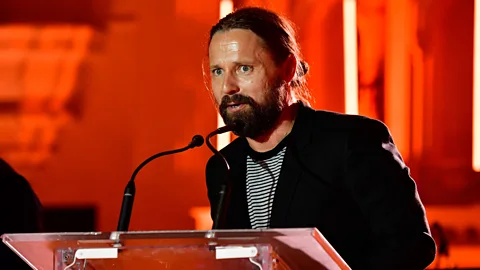Denniz Pop: The man who created the sound of modern pop

In Sweden, the undisputed kings and queens of pop are ABBA – but the real success behind the ‘Swedish Music Miracle’ is owed to a blonde mulleted DJ named Denniz Pop.
Forget rave, grunge and garage – if you were a teenager growing up in the 1990s, the real revolution in music happened in pop. It was an era when the very definition of ‘pop’ went from being a mere abbreviation of the word ‘popular’ to a precise musical theory.
Ever since Elvis Presley first shook his hips, pop has been the sound of teenage bedrooms, school discos and Saturday morning television. But by the turn of the millennium, the pop that dominated our charts hailed from a cold, dark corner of northern Europe called Sweden. This mysterious sound was a rigid formula of melodic minimalism, epic hooks and drops, melancholy, euphoria and mathematical algorithms.
You might also like:
- Eight ideas that changed the history of Western music
Our modern understanding of pop was the brainchild of one man – a blonde mulleted DJ from Stockholm called Dagge Volle. Dagge loved pop music so much he even changed his name – to Denniz Pop. His legacy was to turn Sweden in to a global musical superpower, an unstoppable melodic machine churning out the most successful songwriters of his – and almost every other – generation.
“He just put together a bunch of people who really had nothing to do with each other, and he created this band of brothers,” says songwriter Andreas Carlsson, one of Pop’s disciples. “He was just a music producer, but he had some sort of effect on people. There was something magical, almost religious.”
Perfect pop song
Denniz Pop didn’t fall into music the traditional way. He couldn’t sing, play an instrument, or write a song. What he could do, though, was craft a song from stitching together electronically programmed sounds and beats.
Emerging from the underground club scene in 1986, Pop wasn’t interested in catering for the club crowd alone. Instead, he looked for ways to connect the divide between music that was popular in clubs and music that was popular on the radio. His methods were seen as wildly controversial at the time, according to fellow DJ Stonebridge, who first met Pop at the Ritz nightclub, situated in Stockholm’s Örebro subway station.
 YouTube
YouTube“We couldn’t believe he actually picked the name ‘Pop’. I mean we were scandalised,” says Stonebridge. “For Denniz the challenge was always to create the perfect pop song. He never thought twice about being cool.”
In Britain and America at this time, the underground was a flurry of creative cool, with turntable experiments spawning entirely new musical genres like hip hop and acid house. Pop liked funk and soul, but he also liked to experiment. At the Ritz he noticed that cheesy choruses and simplistic melodies got the biggest dancefloor reaction.
In a basement in Stockholm’s suburbs, Pop brought together an elite team of eight songwriters and producers for a new venture – Cheiron Studios – in 1992. Over the next eight years they would go on to sell hundreds of millions of records through the likes of Ace of Base, 5ive, Robyn, Boyzone, Backstreet Boys, Westlife, *NSYNC and Britney Spears.
Maximum appeal
The secret of their songwriting success was to marry the melody to the beat, not work against it, and to have a big chorus. The team at Cheiron followed Pop’s example, experimenting in clubs across the capital with up to a hundred different versions of each new track – meticulously documenting the combinations of beats and melodies that made the club crowds go wild. Through these experiments, an entirely new genre of music blossomed, one that seemed tailor-made for the age of manufactured boybands and girl groups.
The way Britney Spears’ Baby One More Time was constructed, for example, has influenced all pop music since then. “They took the choruses from hair metal – Bon Jovi and Def Leppard, those very big choruses – and they put them in the context of hip hop and house music production,” says Swedish music journalist Jan Gradvall. “No one in Great Britain or the States would have thought of that, because it was considered bad taste. But as a Swede you could do that.”
What separated Pop’s music from almost every other musical genre that came before it was that it sounded absolutely nothing like the place it came from. In New York, the hip hop pioneers had sought to capture life on the street in song form. In the UK, the sound of acid house utterly embodied disused warehouses and muddy fields. In Stockholm, the music was more reminiscent of shopping malls, stadiums, airports, casinos, gyms and Super Bowl half-time shows.
 LaserCaution/Wikipedia
LaserCaution/WikipediaHaving grown up in socialist Sweden, Pop’s approach to writing music was almost utilitarian. Like so many Swedish success stories – IKEA, H&M, Volvo and Spotify – the Cheiron team wanted their product to appeal to the maximum amount of people, which in a country with a population of only nine million meant focusing outside the nation’s borders. Pop designed his music to reflect the lives of the people who bought more music than anyone else – American teenagers – at least as far as he understood them from his basement in faraway Stockholm.
Singer Robyn suggests this unique way of looking at the world explains why the Swedish Music Miracle could only ever have happened in Sweden, rather than in more resource-rich neighbours like Germany or France. “Swedish people are a little bit like the Japanese in how we can get so obsessed with something, and then try to imitate it or recreate it in some way and then it never becomes what the original is, it becomes maybe a little bit weirder or stranger version of it.”
With each new experiment, Denniz drew closer to creating his perfect pop sound, until his life was cut tragically short. After being diagnosed with stomach cancer in 1997 at the age of 34, Pop was dead less than a year later.
His disciples at Cheiron Studios were left devastated, says Andreas Carlsson. They continued to churn out hit after hit, topping the album charts the world over with the Backstreet Boys Millennium and Britney Spears’ Oops! I Did It Again – just as Pop had taught them.
However, something was missing. “The creativity didn’t come from the same place anymore, what Denniz had stood for, the joy and playfulness wasn’t really there. We were kind of delivering like a factory,” says Carlsson. Within a couple of years, the team disbanded.
But this was only the end of the beginning. Back in 1993, Pop had hired a trainee producer, tea boy and all-round dogsbody Martin Sandberg – who like Denniz Pop would later become known for an altogether poppier epithet ‘Max Martin’.
Melodic Math
As Max rose through the ranks at Cheiron, he ultimately became head of the studio throughout Pop’s illness, carrying the torch after its closure to his new venture MXM Studios in Hollywood, California. For the last 19 years Martin and his team have been turbo-charging the Cheiron formula into a theory they call ‘Melodic Math’.
When I made my programme, Flat Pack Pop, the way melodic math was described to me is that it's more of a philosophy based around moderation and balance. It's a very Swedish thing which has its roots in ideas like Lagom, defined as “just the right amount”, but more widely translated as the virtue of moderation or balance.
 Getty Images
Getty ImagesFor example, if there are a lot of notes in the verse, then you would balance it out by putting very few notes in the chorus. If you have a very punchy staccato chorus then you would balance it out with a loose ambient verse.
The ‘math’ element of melodic math relates to the number of notes or syllables in a particular musical phrase. In order to feel balanced, the notes or syllables have to be equal from line to line. For example, here's the hook line from the chorus of Baby One More Time:
Give me a sign
Hit me baby one more time
Notice how the first line has five syllables and the second line has seven syllables? What Max Martin does to make the ‘math’ of the lyrics fit the ‘math’ of the melody is to elongate the word “sign”, and add extra syllables through vibrato, so it sounds like “Give me a si-i-i-ign”. Now both lines have seven syllables and the ‘math’ is equal.
There are lots of little subrules to melodic math, such as always using the same notes in the intro as you do in the chorus, so that the chorus feels familiar when it comes in (that's an old ABBA trick).
Today Max has 22 US Billboard number one singles to his name – making him the third most successful songwriter of all time behind only John Lennon and Paul McCartney – with hits for Taylor Swift, The Weeknd, Katy Perry, P!nk, Justin Timberlake, Ariana Grande and Maroon 5. Yet despite these extraordinary achievements, most pop fans have never even heard of him.
Perhaps most remarkable of all is that Denniz Pop, Max Martin and Sweden managed to conquer the global music market without anyone ever really noticing. Their relative anonymity is perhaps the most Swedish part of this whole story – as the socialist communitarian principles on which Swedish society is founded encourage humbleness in the face of praise.
By tailoring their music to a global audience, Swedish songwriters inspired by Pop and Martin have achieved far more than they ever could have by instead focusing inwards. When music is specifically designed to appeal to the maximum amount of people, no other type of pop music could ever be more ‘popular’ than that.
James Ballardie is a journalist, who wrote, produced and presented the BBC4 documentary Flat Pack Pop: Sweden's Music Miracle.
If you liked this story, sign up for the weekly bbc.com features newsletter, called “If You Only Read 6 Things This Week”. A handpicked selection of stories from BBC Music, Culture, Capital, Future and Travel, delivered to your inbox every Friday.
{"image":{"pid":""}}
